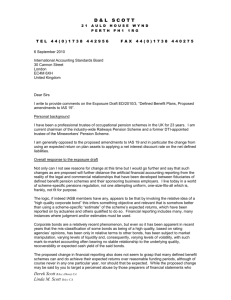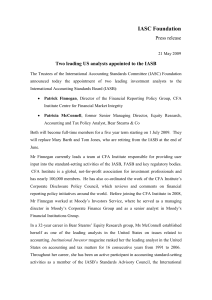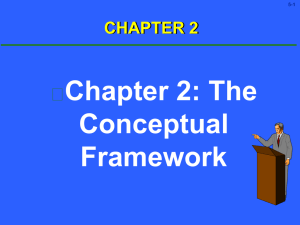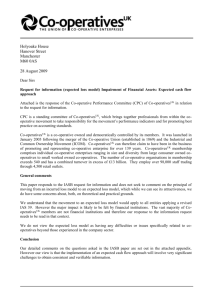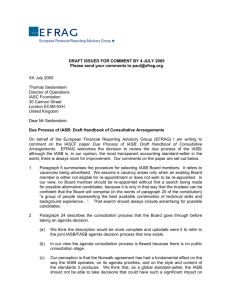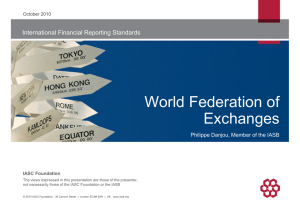国际会计试卷4 解答SOLUTIONS
advertisement
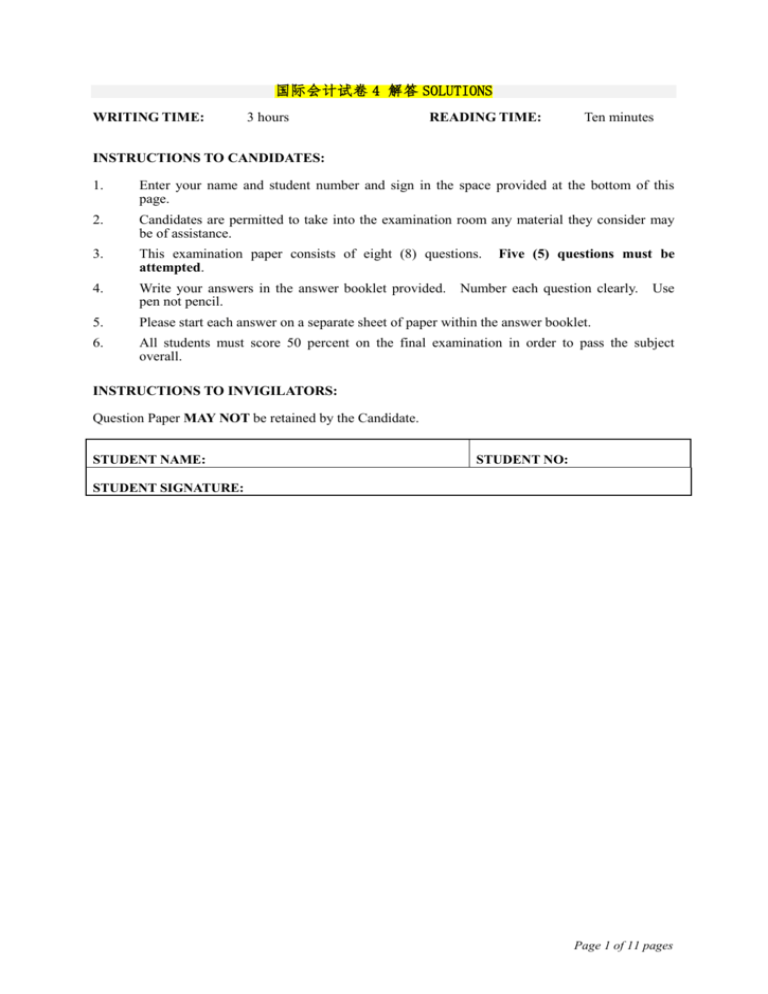
国际会计试卷 4 解答 SOLUTIONS WRITING TIME: 3 hours READING TIME: Ten minutes INSTRUCTIONS TO CANDIDATES: 1. Enter your name and student number and sign in the space provided at the bottom of this page. 2. Candidates are permitted to take into the examination room any material they consider may be of assistance. 3. This examination paper consists of eight (8) questions. attempted. 4. Write your answers in the answer booklet provided. Number each question clearly. Use pen not pencil. 5. Please start each answer on a separate sheet of paper within the answer booklet. 6. All students must score 50 percent on the final examination in order to pass the subject overall. Five (5) questions must be INSTRUCTIONS TO INVIGILATORS: Question Paper MAY NOT be retained by the Candidate. STUDENT NAME: STUDENT NO: STUDENT SIGNATURE: Page 1 of 11 pages QUESTION 1 (20 Marks) In the 13th and 14th centuries, double-entry bookkeeping spread rapidly throughout the western world. What social, economic and political conditions were necessary for widespread adoption of double-entry bookkeeping to occur at that time? How is this an example of the internationalisation of accounting? Necessary conditions (16 marks total): - Rapid growth of trade and commerce - Those travelling to the Holy Land for the crusades from Western Europe inevitably passed through the city states of Northern Italy. - Genoa was at the peak of its power and influence as a trading centre in the 14th century. - In 1252, the gold coin known as the florin was developed in Florence and it became accepted as the standard gold piece in all of Western Europe. - Around this time in Florence, large associations or compagnie (partnerships) were formed to pool capital, first from inside family groups then from outside. - Commune of Genoa (Government) in 1327 required that government accounts had to be kept in same form as used by banks. This is an example of internationalisation of accounting (4 marks) because it shows the growth of larger scale businesses dependent on foreigners for sales and capital. Accounting emerged as a response to the demand for information and the requirement to be accountable. In addition to this, the accounting practices of Florence and Genoa later were transported to England where they replaced the previous manorial system of accounting. This shows how more effective accounting techniques flow across national boundaries. QUESTION 2 (5 + 5 + 5 + 5 = 20 Marks) Answer four (4) of the following: A. To what extent is the strong/weak equity market distinction a useful way to identify different patterns of accounting development. - Strong equity refers to the dominant position of outside equity-holders and the strong legal backing aimed at investor protection. Weak equity refers to the dominant position of banks and family equity-holdings as capital providers, and the legal structure which is designed to safeguard the interests of creditors. Nobes establishes this class distinction in a deductive classification approach. See Figure 3.2 of Radebaugh and Gray (2002). The strong market is US GAAP and the weak market is the IAS GAAP. US GAAP is a powerful factor because the US capital market is very large. IAS GAAP is used in Europe and developing countries. At the outset the IAS reflected a distinct European approach with an emphasis on current value accounting, but both US and IAS regulators are trying to harmonize and the distinctions keep getting smaller between the two GAAPS The increasing globalization of financial markets also reduces the distinctions. · · · · · · B. Do cultural influences impact more significantly upon financial reporting disclosure issues or upon measurement issues? Discuss with examples. A distinction was made between measurement and disclosure practices because these were considered to have separate patterns of development in the Nair and Frank (1980) study (referred to in Radebaugh and Gray, 2002, pp. 39-41). They showed clear differences in the results between the two criteria. However, Page 2 of 11 pages measurement groupings could be made with plausible explanations; but the disclosure groupings offered no plausible descriptions or explanations. The Disclosure country groupings, based on the 1975 Price Waterhouse survey, were British Commonwealth Model, Latin American/ South American Model, Northern and Central European Model, United States Model, and an “Other” category which included only Chile. There were several reliability and relevance problems related to the Price Waterhouse survey data used by Nair and Frank (1980). These problems included data errors, misleading answers, swamping of important questions by trivial ones, and exaggeration of differences between the US and the UK. There was also confusion on the survey between what constituted rules (mandatory and non-mandatory) and the actual practices, which are often different. C. Does culture explain to a significant degree the relative importance of stock exchanges and professional accounting associations around the world? Discuss with examples. Hofstede (1980) argues that culture impacts on institutions and organization as well as occupational groups. Accordingly, there is a plausible link between the Anglo culture, for example, and a preference for stock exchanges and professional association in contrast to the Germanic and Latin cultures. High individualism, low uncertainty avoidance, and low power distance would seem especially relevant here. The answer to Question 3 Part C is also relevant here. D. Where does your country fit in terms of the following key characteristics of accounting practice: “professionalism/statutory control”, “uniformity/flexibility”, “conservatism/optimism”, and “secrecy/transparency”? Explain. According to Gray’s (1988) classification scheme, discussed in Radebaugh and Gray (2002, pp. 45-48), Professionalism versus statutory control relates to the extent to which accountants use their professional judgements and adopt independence attitudes. Uniformity versus flexibility refers to preference for comparability of accounts across companies and across time versus preference for flexibility based on an individual company’s circumstances. Conservatism versus optimism refers to preference for a cautious approach to asset and profit valuation versus preference for an optimistic approach. Secrecy versus transparency refers to preference for confidentiality in disclosure of business data versus preference for information disclosure. Accounting values most relevant to the authority and enforcement aspects of accounting systems seem to be the professionalism and uniformity values. Gray's (1988) proposed classification of countries by cultural area is very subjective and uses the analyses carried out by Hofstede (1980)--not data related to accounting practices. If the student’s classification of their country is well argued, and their classification appears logical, they can be awarded high marks. Figures 3.4 and 3.5 in Radebaugh and Gray (2002, pp. 50-51) can be used to evaluate this. E. What was the Norwalk Agreement of 2002 and what are its implications for accounting standard-setting worldwide and convergence issues? The Norwalk Agreement was an in-principle commitment agreed upon by the International Accounting Standards Board and the Financial Accounting Standards Board to over a period of time work towards convergence of their two sets of standards and to aim towards convergence on any proposed new rules. It can be contrasted with the decisions of Australia and the European Union to adopt wholesale the full set of IASB standards as their own set of national standards. Page 3 of 11 pages QUESTION 3 (5 + 5 + 5 + 5 = 20 Marks) Answer four (4) of the following: A. To what extent are information disclosures by MNEs in directors’ annual reports, as opposed to the financial statements, likely to be useful to financial analysts and investors? The information disclosures in directors' annual reports help investors and other users to better understand the nature and the effects of the activities of MNEs and to better assess performance and future prospects. The information in the directors' report often provides an evaluation of the quality of earnings and financial position, both current and prospective, as opposed to the quantitative information found in the financial statements. The directors' report also gives management an opportunity to communicate more policy and future-oriented information about the corporation to investors and analysts. B. What are some of the potential costs and benefits to MNEs of making additional voluntary information disclosures? The costs to MNEs of making additional information disclosures include the direct costs of assembling and reporting the information and the costs associated with competitive disadvantage--especially the need to maintain business confidentiality in sensitive areas. The benefits include the interests of analysts, investors, and the public in the transparency of multinational operations. The additional information disclosures may influence more investors and affect the corporation's share prices or may lead to more advantageous financing arrangements with creditors. C. In which countries are stock exchange disclosure regulations more stringent? are they less stringent? What are some likely reasons for this? In which countries The United States has the most stringent disclosure regulations in the world followed by Canada and the U.K. At the other end of the spectrum is Switzerland with its regulation for “secrecy” and a number of emerging economies. There are a number of reasons for these differences but the most important would seem to be the size and stage of development of the stock exchange coupled with cultural attitudes to the disclosure of information to outsiders or external groups. If the student refers to other countries other than those listed here, make sure the answer is well argued and logical. D. Why is information concerning future prospects likely to be important to analysts and investors? Why might MNEs not be willing to disclose such information? Financial analysts and investors are often primarily interested in the future prospects of a corporation. Therefore, any additional information relevant to future prospects would be of great interest to financial analysts and investors since directors are usually in a good position to provide insight into future prospects. Corporations are constrained on providing such voluntary disclosures by competitive concerns. Quantitative future-oriented information is very sensitive from a competitive disadvantage perspective. In addition to this, it is not audited. Therefore, the nature and extent of information concerning future prospects is often general and very limited. Page 4 of 11 pages E Recently, the International Accounting Standards Board asked the standard-setting bodies of South Africa, Canada, Australia and Norway to work together to develop an IASB accounting standard for the extractive industries. What do you think of such a move? Why do you think these four countries were selected? These four countries were selected because all are big mining countries and most of the world’s largest mining companies are domiciled in these locations (e.g., Placer Dome in Canada and BHP Billiton and Rio Tinto in Australia). An additional reason is that all four of these countries have a long history of accounting standard-setting and have an accumulated body of accounting expertise and knowledge resident in the country. The student might argue that this is a good move because it allows the knowledge and skills of national accounting standard-setters to be pooled (and so a better accounting standard might eventuate), and it shows the IASB’s willingness to make use of expertise wherever it may be situated around the world. It also reflects the IASB’s maintained position that countries and entities most directly affected by an accounting rule should be able to have an input into its formulation. QUESTION 4 (5 + 5 + 5 + 5 = 20 Marks) Answer four (4) of the following: A. Discuss the ways in which the European Union might become involved in the future in the international accounting standard setting process. The scope of the EU’s accounting Directives is limited to the member states, though their influence goes beyond to Switzerland and to countries wishing to join such as Hungary and Malta. It is unlikely that there will be any new Directives or amendments for the foreseeable future. The European Accounting Advisory Forum is thus the prime means by which changes will be brought about at the EU level. The EU also seems to have accepted the authority of the IASB as the appropriate body to set global standards in the future. At the same time, the EU appears concerned to influence future developments through its representation at the IASB and IOSCO, and to protect European interests and accounting traditions. The EU has also been at the forefront of releasing policy documents relating to environmental and social accounting. B. Outline the major perceived advantages and disadvantages of the IOSCO endorsement of IASB standards. The mission of the IOSCO is the global coordination of stock exchange rules to facilitate multi-listing and cross-border capital raising by MNEs and encourage international securities trading. What IOSCO support does for the IASB is to give added authority to its status as the body responsible for accounting standard-setting on a worldwide basis. But, more importantly, it provides a likely means of enforcement of its standards as national securities agencies (e.g., ASIC in Australia) have the power to require such standards to be followed for stock exchange listing purposes. C. Should international accounting standards be set for the world or be restricted to MNEs interested in raising finance from international investors? Discuss. Because this is a normative question, alternative viewpoint on the issues are permitted. Any well reasoned and logical answer should be awarded high marks. Note that there is no single correct answer on this issue. Page 5 of 11 pages D. Should the IASB have the authority to set international accounting standards or should the standards be the outcome of a more collaborative/consultative exercise? Discuss. Because this is a normative question, alternative viewpoint on the issues are permitted. Any well reasoned and logical answer should be awarded high marks. Note that there is no single correct answer on this issue. E. In Australia, the IASB set of accounting standards are mandatory as from 1 January 2005. How does the degree of applicability of the IASB standards in European Union countries post 2005 differ from the degree of applicability of this set of accounting standards in Australia? The Australian concept of “reporting entity” in Statement of Accounting Concepts 1 still continues to apply. This means that the IFRS must be followed by all reporting entities, including larger private companies and not-for-profit organisations. In the European Union, conformity with IFRS is limited to the consolidated (group) accounts and to listed companies. Therefore, comparatively more organisations will be affected in Australia by the move to IFRS than will be affected in the EU. These issues may not have been properly thought through at the time that Australia rushed to accept IASB adoption by 1 January 2005 (Alfredson, 2003; Haswell and McKinnon, 2003). Page 6 of 11 pages QUESTION 5 (5 + 5 + 5 + 5 = 20 Marks) Answer four (4) of the following: A. Compare and contrast the different formats for financial statement consolidation. Make sure that your answer includes reference to the following methods of consolidation; full, proportional and equity. The quality and quantity of consolidated information varies considerably both between and within countries. Apart from the United States, United Kingdom, and the EU countries, legal and professional requirements relating to consolidated statements are not yet as comprehensive as might be expected. The methods of consolidation include the following: · · · · B. The full method, common with corporations that have wholly-owned subsidiaries or controlling interests in other corporations, involves a "line-by-line" consolidation of all accounts. The proportional method, considered appropriate for joint ventures, involves the consolidation of only the ownership share of assets and liabilities on a pro-rata basis. The equity method, used when there is a significant influence but not controlling interest in another entity, involves consolidating a share of the profits on a "one-line" basis according to the equity owned by the MNE. The cost method, whereby only dividends are included in the results for the year, is also widely used in countries such as Australia and Sweden. Why has joint venture accounting become a much more important issue now than it was (say) in the 1970s? Why has it been difficult to get agreement internationally about the appropriate accounting treatment for joint ventures? Joint-venture accounting is becoming increasingly important with the growth of collaborative arrangements between MNEs and host governments/domestic corporations, especially in the emerging economies of Russia, Eastern Europe, and China. MNEs themselves are also forging alliances to access new markets on technology. This trend looks likely to continue and some theorists suggest that we have entered an age of “Alliance Capitalism.” The alternatives of proportional consolidation versus the equity method are controversial because of differing views concerning the nature of consolidation, i.e. should the forms be on the assets and liabilities deployed in respect of which the investor company is assumed to have some control (proportional approach) or should the focus be on the net investment or equity in which the investor company has rights? Major problems arise in the context of joint-ventures in countries with centrally-planned economies (ie. China and Russia) where accounting has a very different purpose (means of centralized control) than accounting in western countries. Differences have also arisen in the approach taken (receipts and payments approach vs. accruals approach), asset valuation, depreciation, treatment of liabilities, and the use of fund accounting for a variety of purposes. Most of the problems associated with accounting for joint-ventures involve coordinating different cultural and accounting traditions in a way that resolves issues relating to financial control, the measurement of profit, and the valuation of joint-venture investments. C. Why did Australian companies such as News Corporation strongly oppose the accounting rules contained within IAS 38: Intangible Assets? Media corporations such as New Corporation argued strongly that IAS 38, which requires systematic amortisation of finite life identifiable intangible assets (no requirement similar to this existed in Australia prior to the adoption of IAS 38), fails to reflect economic reality. The reason given is that, since many of Page 7 of 11 pages these assets (e.g., television licences, newspaper mastheads) convey monopoly rights to future cash flows, they do not diminish in value over time if properly managed. As a result, these companies argued that adoption of IAS 38 in Australia would significantly reduce total assets and total profits for these companies below what were their true values. In addition, under IAS 38, intangibles can not be stated at re-valued amounts unless the asset is traded on an “active market”. No active market will exist for television licences or newspaper mastheads. This is an additional way in which IAS 38 changes accounting practices traditionally used by media companies in Australia. D. Why is accounting for identifiable intangible assets an important issue for developing countries? As developing countries, including the emerging economies of Russia, Eastern Europe and China, privatize state-owned corporations and become more market-oriented economies, so has the issue of intangibles become more important. The reason for this is that valuations need to be placed on businesses that incorporate intangibles such as R&D, brand names and market know how in a context where there is a significant lack of information available upon which to base the necessary judgments. In addition, there is a shortage of skilled and qualified practising accountants in these countries who can determine and audit reported intangible asset values. E. Why do you think developing countries such as Pakistan and Malaysia made the policy decision to adopt the full set of IASB standards wholesale as their own set of national standards rather than develop their own set internally? One important reason is that these countries would regard adopting the IASB set of standards completely as their national standards as cost-beneficial because it saves them the cost and time required to develop their own accounting standard-setting bodies and processes internally. They may also feel that there is a shortage of skilled local accountants who can provide thought input into the accounting standards deliberation process. Another reason is that these countries are hoping that full adoption of IASB will signal to international investors and MNEs that reporting quality in the country is high. As a result, investment funds flows into the country are more likely to be maximised. In this respect, full adoption of IASBs is likely to be a “public relations exercise” to a certain degree. Lastly, an interesting point is that Pakistan and Malaysia are both Islamic countries. Islam prohibits the use of debt financing. In Pakistan, non-Islamic forms of banking have been outlawed since 1992, whilst in Malaysia Western and Islamic banking exist side by side. The “time value of money” concept and discounting procedure arguably have no place within Islamic societies. By contrast, many of the IFRS standards incorporate discounting concepts (Hamid et al., 1993; Deegan, 2000). Islamic students might be able to add further interesting comment and opinion on this issue. QUESTION 6 (20 Marks) Discuss the most important advantages and disadvantages of Australia’s full adoption of the IASB set of accounting standards from 1 January 2005. Please include at least three (3) arguments for both sides. Rate each argument out of ten (10) based on your own personal opinion as to its merit. Advantages (8 marks): - Enhanced comparability and understand-ability of reports. - May lower the cost of capital, especially given that Australia’s capital market is small by world standards and the nation is a “price-taker”. - Will allow easy listing for companies already listed on the LSE. IASB standards acceptable on both ASX and LSE. - Cheaper arrangement because the cost of maintaining a local standard setting apparatus is reduced. - Reduces costs and burdens upon MNEs because they can use only one basis for reporting. - More politically acceptable to the Australian Federal Government because future Australian corporate failures can be blamed on poor accounting standards issued by a non-Australian body. Page 8 of 11 pages Disadvantages (8 marks): -Australian accounting standards perceived as high quality by many neutral observers. Australia should be more than a “rubber stamp” for IASB standards. - Some local issues may not be covered by international rules or there may be interpretation and applicability issues. - The US remains the world’s largest capital market and the New York Stock Exchange presently does not accept accounts prepared according to IASB unless accompanied by a reconciliation to US GAAP. The hurried move to IASB has been viewed by some as a political move by the Australian Federal Government because future Australian corporate failures can be blamed on poor accounting standards issued by a non-Australian body Any reasonable attempt by the student to assign a mark out of ten to these advantages and disadvantages, if accompanied by logical reasoning, can be awarded 4 marks. QUESTION 7 A. (7 + 7 + 6 = 20 Marks) Critically evaluate the alleged advantages of mandated segment disclosures. Include in your answer the most important results from predictive ability and stock market research. Predictive ability (forecasting) tests and stock market reaction tests have been performed to determine the benefits of LOB and geographic segmental information. These methods have been used to help avoid the problems of ignorance and "gaming" in the context of user surveys. Segmental reporting helps users to better forecast the performance of and evaluate the risk associated with an entity. Predictive ability studies (reviewed in Radebaugh and Gray, 2002, ch. 8) have all concluded that forecasts are more accurate if they are based on LOB segmental data rather than consolidated earnings. Recent earnings-prediction studies also indicate that forecasts based on geographical segmental disclosures are more accurate than those based on consolidated earnings (e.g., Roberts, 1990 and Balakrishnan, Harris and Sen, 1990, as discussed in Radebaugh and Gray, 2002, p. 199). In addition, stock market studies indicate that disclosure of both LOB and geographical segment data results in a decrease in market assessments of risk of the disclosing corporation. B. Outline some of the major issues that have arisen in the real world concerning the content and presentation of segment disclosures. A number of problems arise in auditing and verifying disclosed segmental information. Particular problems involve common cost allocations, intra-group transfers, and transfer pricing. Another major problem is determining whether the identified segments are reasonable. A lack of guidance in identifying segments in most countries implies that corporations can manipulate disclosures to present the best possible picture of their operations. While this lack of guidance allows MNEs to provide more relevant disclosures that are specific to their operations, it also decreases comparability among corporations. C. If risks of operating in a certain foreign country are very high, do you think that segment disclosure for operations in that country should be mandatory, even if the assets involved comprise only (say) 5% of total assets for the company? In principle, it could be argued that segment data about Mexico should be reported if the risks are high and there is a good chance of a loss. However, this generalization may warrant qualification according to the materiality of the assets at stake. How should materiality be determined? This is Page 9 of 11 pages arbitrary although percentages up to 10% are often considered not material in practice. If the amount is considered significant, irrespective of the percentage, then disclosure would seem appropriate. QUESTION 8 (5 + 5 + 5 + 5 = 20 Marks) Answer four (4) of the following: A. In May 2000, Nissan announced that it would close some factories in Japan and shift some of its production operations to the United States. What type of foreign exchange is Nissan trying to protect itself from? Explain fully. Discuss the advantages and disadvantages of using forward contracts to hedge sales to the United States as opposed to shifting production operations there. The pros are that forward contracts can be used to hedge foreign sales in a way that will create profits from the transactions. Having the funds be in the home country currency permits greater corporate control and flexibility. The cons are that forward contracts cost money and are always easy to construct to match numerous transactions or forecasted activities. If the company chooses not to perfectly hedge, then additional risk exposure occurs. Generally, larger firms like Nissan have other objectives than foreign exchange risk affecting the decision. The decision to locate production in other countries requires an evaluation of all applicable factors. It is unlikely that FX should be the driving factor because of the ability to hedge a significant portion of FX risk. B. If there are potential foreign exchange losses from receivables and payables being denominated in a foreign currency, why don’t firms just demand that all receivables and payables be denominated in their own currency? For every buyer, there is a seller. One party in the transaction will have to make an exchange of currency. Generally, institutional factors and market power impact on the denomination of transactions. So, in other words, very often a company does not have the power or ability to demand that their receivables and payables be denominated in their own currency. It depends on the influence of their currency globally. A US company, for example, is more likely to have a higher proportion of its receivables and payables denominated in its home currency than is a Jordanian or Peruvian company. C. Explain the current cost system adopted voluntarily by Philips (The Netherlands). What was their stated justification for reverting back to historical cost in their published 1992 accounts? Do you feel that this choice was justified? Philips uses current values with a gearing adjustment to reflect the benefits accruing from financing assets from loan rather than equity capital. Replacement values are generally used to determine current values, although the net realizable value is used in certain instances. Standard costs are determined at the beginning of the year for inventory, and indices are developed to account for price changes during the year. Current values are determined by the purchasing department and the engineering departments for fixed assets, and indices are used to update these values. The effect of current value changes should show up in the income statement as a higher cost of goods sold (as a result of increases in inventory prices) and higher depreciation expense. However, the fall in inventory prices coupled with the favourable effect of the gearing and other adjustments tended to boost Philips’ profits in a somewhat misleading way in the late 1980's early 1990's. The reasons given by Philips for reverting to historical cost were: 1. Improve communication with shareholders 2. Considerably simplify accounting systems and procedures 3. Be more in line with current international accounting practices D. Outline the conditions that are likely to be prevalent in a country before we see the widespread Page 10 of 11 pages voluntary adoption of inflation-adjusted accounting techniques? Corporations are likely to voluntarily disclose the impact of price changes and inflation when they have operations in hyper-inflationary economies and historical values would harm the corporation's position with investors and creditors. Corporations are likely to disclose the impact of inflation only when the perceived benefits exceed the costs of preparing and disclosing such information. E. In Germany, there has been historical resistance to any form of current cost accounting and a strong loyalty to historical cost. Why do you think this has been the case? German accounting is highly conservative and aims to reduce uncertainty about measurement and cope better with the unpredictability of future events. The concern about inflation accounting, which is very imprecise in measurement terms, can thus be readily understood. The experience of hyper-inflation in the 1920's is also understood to have made regulators wary of introducing inflation accounting on the ground that this might institutionalize inflation and so perpetuate rather than cure it. Inflation in Germany in recent years has, in any event, been very low and so this has not been a serious issue. At the same time, price changes often vary significantly so it could be argued that in theory, current value accounting would be useful--subject to an assessment of the costs and benefits involved. F. Sir David Tweedie, head of the IASB, made the public claim on his 2002 visit to Australia that accounting abuses associated with corporate collapses such as Enron and Worldcom would not have occurred had the United States adopted IASB standards in their entirety. Why was this statement influential in changing the relative public status and reputation of the IASB and the American FASB? This statement was very influential and important in helping investors around the world understand the severe limitations associated with the FASB’s “rules-based” (as opposed to “principles-based”) set of accounting standards, especially in the area of consolidated financial statements. Sir David remains a shrewd marketer of his organisation’s standards. Since his statement, the reputation capital connected with the FASB and its standards have definitely declined around the world, while that of the IASB and its standards have risen. As a result, the FASB has been willing to work with the IASB on long-term convergence goals (e.g., the Norwalk Agreement), which would have been unthinkable a decade ago. The New York Stock Exchange (NYSE) is also very aware that maintaining its Form 20-f reconciliation requirement (requiring foreign companies to provide a reconciliation of their profit computed under IFRSs to what it would have been under US GAAP) is causing many foreign companies to prefer to list on exchanges such as London, Hong Kong and Australia, where no equivalent requirement exists and conformity with IFRS is acceptable. Page 11 of 11 pages

